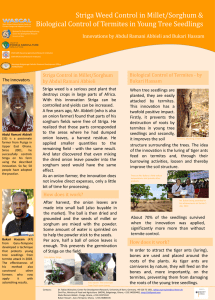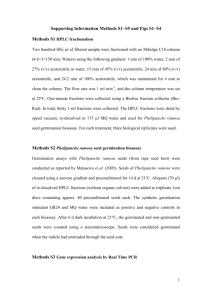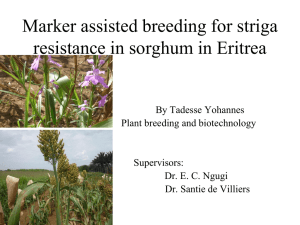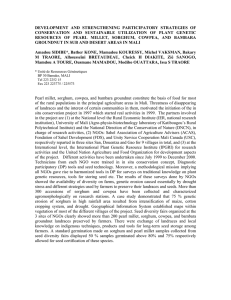ISSN: 1992-1705 Life Sci. Int. J., Vol: 3, Issue
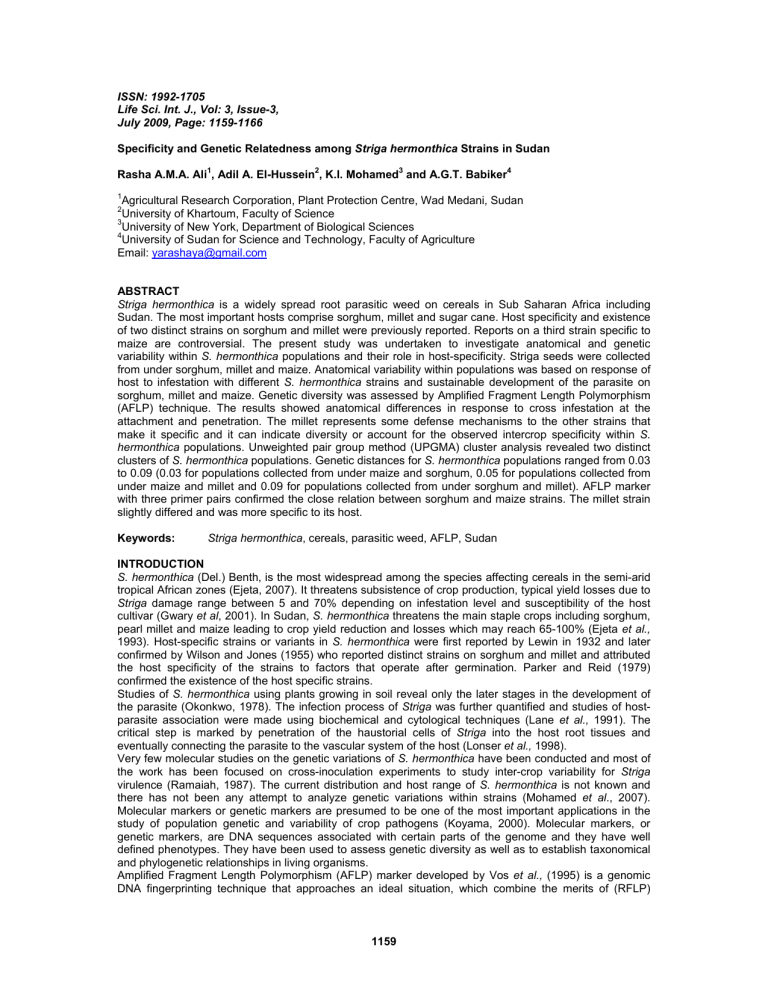
ISSN: 1992-1705
Life Sci. Int. J., Vol: 3, Issue-3,
July 2009, Page: 1159-1166
Specificity and Genetic Relatedness among
Striga hermonthica
Strains in Sudan
Rasha A.M.A. Ali 1 , Adil A. El-Hussein 2 , K.I. Mohamed 3 and A.G.T. Babiker 4
1 Agricultural Research Corporation, Plant Protection Centre, Wad Medani, Sudan
2
University of Khartoum, Faculty of Science
3
University of New York, Department of Biological Sciences
4
University of Sudan for Science and Technology, Faculty of Agriculture
Email: yarashaya@gmail.com
ABSTRACT
Striga hermonthica is a widely spread root parasitic weed on cereals in Sub Saharan Africa including
Sudan. The most important hosts comprise sorghum, millet and sugar cane. Host specificity and existence of two distinct strains on sorghum and millet were previously reported. Reports on a third strain specific to maize are controversial. The present study was undertaken to investigate anatomical and genetic variability within S. hermonthica populations and their role in host-specificity. Striga seeds were collected from under sorghum, millet and maize. Anatomical variability within populations was based on response of host to infestation with different S. hermonthica strains and sustainable development of the parasite on sorghum, millet and maize. Genetic diversity was assessed by Amplified Fragment Length Polymorphism
(AFLP) technique. The results showed anatomical differences in response to cross infestation at the attachment and penetration. The millet represents some defense mechanisms to the other strains that make it specific and it can indicate diversity or account for the observed intercrop specificity within S. hermonthica populations. Unweighted pair group method (UPGMA) cluster analysis revealed two distinct clusters of
S. hermonthica
populations. Genetic distances for
S. hermonthica populations ranged from 0.03 to 0.09 (0.03 for populations collected from under maize and sorghum, 0.05 for populations collected from under maize and millet and 0.09 for populations collected from under sorghum and millet). AFLP marker with three primer pairs confirmed the close relation between sorghum and maize strains. The millet strain slightly differed and was more specific to its host.
Keywords:
Striga hermonthica
INTRODUCTION
, cereals, parasitic weed, AFLP, Sudan
S. hermonthica (Del.) Benth, is the most widespread among the species affecting cereals in the semi-arid tropical African zones (Ejeta, 2007). It threatens subsistence of crop production, typical yield losses due to
Striga damage range between 5 and 70% depending on infestation level and susceptibility of the host cultivar (Gwary et al
, 2001). In Sudan,
S. hermonthica
threatens the main staple crops including sorghum, pearl millet and maize leading to crop yield reduction and losses which may reach 65-100% (Ejeta et al.,
1993). Host-specific strains or variants in
S. hermonthica
were first reported by Lewin in 1932 and later confirmed by Wilson and Jones (1955) who reported distinct strains on sorghum and millet and attributed the host specificity of the strains to factors that operate after germination. Parker and Reid (1979) confirmed the existence of the host specific strains.
Studies of
S. hermonthica using plants growing in soil reveal only the later stages in the development of the parasite (Okonkwo, 1978). The infection process of Striga was further quantified and studies of hostparasite association were made using biochemical and cytological techniques (Lane et al.,
1991). The critical step is marked by penetration of the haustorial cells of Striga into the host root tissues and eventually connecting the parasite to the vascular system of the host (Lonser et al.,
1998).
Very few molecular studies on the genetic variations of
S. hermonthica
have been conducted and most of the work has been focused on cross-inoculation experiments to study inter-crop variability for
Striga virulence (Ramaiah, 1987). The current distribution and host range of
S. hermonthica
is not known and there has not been any attempt to analyze genetic variations within strains (Mohamed et al ., 2007).
Molecular markers or genetic markers are presumed to be one of the most important applications in the study of population genetic and variability of crop pathogens (Koyama, 2000). Molecular markers, or genetic markers, are DNA sequences associated with certain parts of the genome and they have well defined phenotypes. They have been used to assess genetic diversity as well as to establish taxonomical and phylogenetic relationships in living organisms.
Amplified Fragment Length Polymorphism (AFLP) marker developed by Vos et al., (1995) is a genomic
DNA fingerprinting technique that approaches an ideal situation, which combine the merits of (RFLP)
1159
Rasha, et al. (2009). Specificity and Genetic Relatedness…
Restriction Fragment Length Polymorphism and Random Amplified Polymorphic DNA (RAPD) markers.
AFLP is applied to many uses such as genetic mapping and cloned DNA sequences in a variety of cultivated species as well as the study of genetic variation within populations (Yan and Aaron 2003). The main disadvantage of AFLP is the difficulty in identifying homologous markers (alleles) however; AFLPs are emerging as powerful addition to the molecular toolkit of ecologists and evolutionary biologists (Muller and Wolfenbarger, 1999).
MATERIAL AND METHODS
Anatomical Studies
In this study, the soft tissue method as described by John (1958) was adopted. Soft fresh roots (96 h old) infected with Striga were placed in a fixative (formalin: acetic acid: ethanol, 5:5:90 v/v). The roots were dehydrated by transfer through a series of ethyl alcohol concentrations containing Eosin. The roots were cleared by placing them in xylene for 6 h prior to transfer to a mixture of xylene and paraffin wax (50/50 v/v) for 6 h. Specimens were transferred from xylene-paraffin wax mixture to wax, placed at 60°C for 12 h and poured in blocks before sectioning. Sectioning to a thickness of 12 microns was done using a rotatory microtome (Letize1512-west Germany). Ribbons were collected and transferred to glass slides. The slides were dehydrated by placing on a hot plate and transferred to a slide dressed with 4% albumin.
Dehydrated specimens were dewaxed, rehydrated and then stained with safranine. A reversible dehydration process was carried out, prior to emersion of the specimens in fast green stain for 1 minute and washed in absolute alcohol and xylene. The prepared sections were mounted on a drop of DPX-72 and examined under microscope and photography.
Assessment of variability among S. hermonthica population s using AFLP marker
DNA Extraction from
Striga
leaves
S. hermonthica seedlings were raised on their respective host using potted soil in a green house. Newly emerged
Striga
leaves were harvested and washed first with distilled water and subsequently with alcohol
(70%). DNA was extracted using the method described by Arun e t al, (2002). The extraction buffer was prepared by mixing 0.17 µl β - mercaptoethanol (preheated at 65º C) with 750 µl of 3% CTAB buffer
(hexadecyltrimethylammonium bromide, 5M NaCl, 0.5 M EDTA, 1M Tris-HCl pH 8.0). 0.1- 0.2g leaf powder was transferred to the extraction buffer mixed thoroughly and incubated at 65ºC for 30-40 min. A mixture (700 µl) of chloroform and isoamylalcohol (24:1) was added to each sample and mixed prior to centrifugation at 10,000 rpm for 10 min. The supernatant (aqueous phase) was collected, mixed with an equal volume of cold isopropanol and centrifuged at 12,000 rpm for 15 min. The supernatant was decanted and the residue was air dried. The obtained pellets were suspended each in 300 µl of low salt
(T
1.0
E
0.1
). A mixture (300µl) of phenol, chloroform, isoamylalcohol (25:24:1 v/v) was added and mixed prior to centrifugation at 6,000 rpm for 5 minutes. The supernatant was decanted, residue was air dried and the resultant pellet was suspended in a mixture (300 µl) of chloroform- isoamyl alcohol (24:1 v/v) and centrifuged at 5,000 rpm for 5 min. The supernatant was mixed with 15 µl of 3 M sodium acetate in a new eppendorf’s tube and the volume was completed by ethanol. The eppendorf’s tube was kept at -20ºC for
10min and centrifuged at 12,000 rpm for 12minutes. The supernatant was decanted and the residue was air dried, the pellets were resuspended in 300 µl of 70% ethanol prior to centrifugation at 7,000 rpm for 5 min. The supernatant was decanted, the pellets were air dried for 20-30min and resuspended in 100 µl of
T
10
E
1
. The resulting suspension was considered as the DNA sample and stored at 4ºC till used.
AFLP process
DNA was adjusted to 100ng/µl before AFLP reactions. AFLP reactions were performed using the protocol described by Vos et al
. (1995) with minor modifications and optimized for capillary electrophoresis as described by Kim et al , (2004). Two (Fisher) restriction enzymes (EcoR1 and Mse1) with three (IDT) pairs of primers and their adaptors were used. The primers combinations used were: Eco ATT -Mse CAA, Eco
AGG –Mse CAC and Eco ACC -Mse CAG (Mohamed, 2007).
Digestion/Ligation (DIG-LIG)
The adapter pairs were heated at 95ºC for 5 min. and allowed to cool to room temperature for 10 min.
A master mix [14.5µl 10 х T4 DNA ligase buffer, 7.3µl (1M) NaCl, 0.7 µl BSA (10mg/ml), 13.2 µl (20 µM) Mse1 adapter pair, 13.2 µl (2 µM) EcoR1adapter pair, 6.6 µl Mse1 restriction enzyme (10 U/µl), 6.6 µl EcoR1 restriction enzyme (10 U/µl) and T4 DNA ligase (3 U/µl)] was prepared in Eppendrof’ tubes, mixed well and set aside on ice. DNA samples (5 μ l each) were then added and 5 μ l of RL mix were added to each tube.
The tubes were incubated at 37 ºC for 2 h, centrifuged at 14000 rpm for 10 sec and diluted with 190 μ l of
1 х TLE.
Pre-Selective PCR
1160
Rasha, et al. (2009). Specificity and Genetic Relatedness…
A master mix for the PCR was prepared by mixing 142 µl sterile H
2
O, 26.4 µl 10x PCR Buffer, 21.1µl dNTPs, 7.9 µl MgCl
2,
6.6 µl Eco A primer (10 uM) and 6.6 µl Mse C primer (10 uM). DIG-LIG samples (4 µl each) were added to its corresponding 0.2-ml tubes. Taq (1.056 µl) was added to the master mix just prior to use. Sixteen µl of master mix spiked with Taq was added to each tube, placed in a thermo cycler. The
PCR profile run was as follows: 72ºC for 3 min, followed by 20 repetitive cycles at 94ºC for 20 seconds,
56ºC for 30 seconds, and 72ºC for 2 min, with a final hold at 60ºC for 30 min. All samples were stored at
4ºC at the end of PCR profile run.
Selective PCR
A master mix was prepared by mixing 55.6 µl sterile H
2
O, 14.4 µl 10X PCR buffer, 11.5 dNTPs, 4.3 µl
MgCl
2
, 7.2 µl Eco A primer (10uM) and 7.2 µl Mse C primer (10 uM). Pre-selective PCR product (10 µl) was diluted with 190 µl of 1x TLE, mixed thoroughly and centrifuged at 1400 rpm for 10 seconds. The diluted pre-selective PCR samples (3 µl) were added to the master mix in an Eppendrof tube followed by addition of Taq polymerase (0.576 µl). To each tube 7µl of the mix (master mix plus pre-selective PCR product) were added, placed in a thermocycler and run. The PCR program for the selected amplification consisted of an initial warm-up at 94ºC for two min, one cycle of 94ºC for 20 sec, 66ºC for 30 sec, 72ºC for
2 min, followed by ten subsequent cycles, each with a 1ºC lowering of the annealing temperature, followed by 25 cycles of 94ºC for 20 sec, 56ºC for 30 sec and 72ºC for two min and finally a hold of 30 min at 60ºC before storing the samples at 4ºC.
Post-reaction Sample Preparation for CEQ Run
Diluted PCR Product (2 µl) was mixed with 0.5 µl of CEQ standard size 600 in each of well of a sequencer plate. Thirty µl of Sample Loading Solution and one drop of mineral oil were added to each well.
Separation was performed using capillary electrophoresis on an automated CEQ8000 DNA fragment analysis/sequencer (Beckman- Coulter, Inc.). The CEQ running conditions were: denaturation at 90 ºC for
120 sec, injection for 30 sec at 2kv and separation at 4.8 kv for 60 min.
Data analysis
Fragment sizes were automatically calculated by CEQ8000 software using local southern sizing algorithms. Amplified fragments were treated as a separate character and scored as either present (1) or absent (0). UPGMA program version 3.5 (neighbour procedure) was used to calculate the genetic distance
(Nei, 1978). A dendrogram using unweighted pair group method (UPGMA) (Sneath and Sokal, 1973) was constructed for estimating the genetic similarity based on Nei’s coefficients among populations.
RESULTS
Anatomical studies
Haustorial development began when radicles of S. hermonthica were placed in contact with host or nonhost roots. There was little detectable evidence of disruption by mechanical force in the host cells in the area where the parasite advanced into the cortex (Plate 1). Host cortical cells in close proximity to the penetration site did not exhibit hypertrophic or hyperplastic reactions (Plate 2a, b and c). The cotyledons in
Striga, on each of the true hosts, enlarged and broke off the seed coat and small Striga plantlets with scale leaves developed. The shoot apex elongated beyond the cotyledons. The plumular poles developed into distinct shoots with short internodes and numerous scale leaves. The L.S. showed clearly enlargement of the distialmost cells of the endophyte and establishment of a palisade like arrangement of cells.
S. hermonthica , sorghum population, which succeeded in penetration of millet roots showed cells with small diameter and densely stained walls. Furthermore, a thick deposit, which stained densely with fast green, developed at the interface between the advancing endophyte and millet root cells (Plate 2b). None of the populations showed such a differential symptoms when parasitizing its appropriate host (Plate 3).
AFLP analysis of genetic variability within S. hermonthica populations
An AFLP profile analysis of the three populations run on ECQ 8000 with three primer pairs generated many fragments each with different alleles (Fig. 1). Each primer pair tested produced positive amplicon with the three
S. hermonthica
populations studied
.
The data showed the presence of 14 alleles that are common in the three S. hermonthica populations. In addition to these, two alleles were detected in millet S. hermonthica population only, one allele in both sorghum and maize populations, and one in both millet and maize populations and one in sorghum and millet populations. Estimates of genetic identity and genetic distance among the three
S. hermonthica populations using UPGMA program version 3.5 and the primers
Eco ATT-CAA, Eco AGG-CAC and Eco ACC-CAG showed that
S. hermonthica
sorghum and maize populations were closely similar (93%). Genetic identity between S. hermonthica sorghum and millet populations was 88% while that of
S. hermonthica
maize and millet populations was 91% (Table 1).
Genetic distances was 0.03 for S. hermonthica sorghum and maize population, 0.09 for S. hermonthica sorghum and millet populations and 0.05 for
S. hermonthica
millet and maize populations (Table 2).
A dendrogram showed that S. hermonthica populations were clustered in two groups. Group 1 comprised the sorghum and maize populations, while the millet population constituted the second group (Fig. 2). The estimated clade length between S. hermonthica sorghum population and the group 1 was 1.68931.
1161
Rasha, et al. (2009). Specificity and Genetic Relatedness…
A similar length was estimated within group 1 and
S. hermonthica
maize population. The clade length of
S. hermonthica millet population with group 2 was 3.42980. The clade length between group I and Group II was 1.74049 (Table3).
DISCUSSION
S. hermonthica is the most damaging pest encountered by farmers growing sorghum, millet, and maize in
Sub Saharan Africa. It is a noxious weed and is well adapted to its host and the environment comprising agro-ecosystems and climates (Mohamed et al.
, 2007). Parasitic plants have evolved special mechanisms to enable them to acquire resources from their hosts (Musselman, 1987). Their ability to access host vascular tissues and withdraw resources through haustoria depends on the species of the parasitic plant.
The haustorium interconnects either the host and parasite xylem (Dorr, 1997), the phloem (Hibberd et al.,
1999) or the interfacial parenchyma (Tennakoon and Cameron, 2006), or a combination of the three
(Duncan et al., 2007).
The attacked plant may be able to respond to infection by the parasite through a number of mechanisms.
The host may innately possess or be induced to form an obstruction to the intruding haustorium by chemical, nutritional and/or mechanical barriers (Goldwasser et al
., 2000). Histological investigations undertaken in this study showed the presence of material(s), which stained dark, at the host parasite interface in the cortex of millet when the root was penetrated by sorghum and maize populations of
S. hermonthica (Plate 2), while the infected roots of sorghum and maize did not show such material(s). These findings are in agreement with various reports on
Striga
(Arnaud et al.,
(1999). The observed darkly stained materials may be attributed, as pointed out by Hood (1998), to accumulation of defensive chemicals induced in the host. Most of these materials were reported to be phenolic compounds leading to suberization and lignifications of host cells (Duncan et al ., 2006). Joel et al. (2006) identified several substances from both host and parasite. One of these substances, a carbohydrate, accumulated only inside the host vessels away from the haustorium core. Other compounds and/or polymeric materials fill the apoplast close to the haustorium and the intracellular space and cell walls. Perez et al.
(2006) suggested that the darkening of tissue is a secondary symptom which develops as a result of the operation of different types of resistant mechanisms that discourage parasite development. At the early stages of penetration, parasitic plants were reported to release enzymes that allow penetration of intrusive substances into the host cells (Joel et al.,
1995) and the host may react to evade the invasion and as a result may show localized die back at host /parasite interface. Results from the present study indicate the possibility of involvement of mechanical and/or enzymatic lysis in the penetration process. S. hermonthica penetrates, at least in part, through a rupture effect (Plate 3).
The genetic variability of S. hermonthica has not been sufficiently evaluated relative to its wide distribution and host specificity. AFLP markers have been widely reported and are distributed throughout the plant genome (Vos et al,. 1995). The present study, inferring from clustering by genetic distance, suggests that
S. hermonthica sorghum and maize populations are closely related while the millet population is distinct
(Fig.1). The short clade is between the S. hermonthica sorghum and maize populations and the long one is in between them and the millet population. A conceivable explanation to this observation is that the
Striga millet and sorghum populations developed early in the evolution. It is possible that isolation of Striga populations through time and space led to development of the two distinct populations. Genetic diversity between S. hermonthica populations may be more obvious if more samples from each population were used. Sorghum and millet are indigenous crops in African Savanna where
Striga
is known to exist and thrive best. Maize has its centers of origin in the Americas and it was introduced relatively recently.
The presence of unique alleles in millet population might suggest that their marker alleles are linked to specificity genes. This may be made use of for Striga control by targeting these genes in the future, using more markers, clones for co- suppression and gene silencing.
The study, on the basis of penetration and genetic distance, confirm clearly the existence of millet and sorghum strains in
S. hermonthica
. However, with respect to maize strain no sharp conclusion can be made. The minor differences in virulence and genetic distance observed between the two populations could be attributed to provincial differences.
Striga
from under maize was collected from Damazine while the one from under sorghum was collected from Wad Medani.
1162
Rasha, et al. (2009). Specificity and Genetic Relatedness…
REFERENCES
Arnaud MC, Veronesi C and Thalouarn P (1999). Physiology and histology of resistance to Striga hermonthica in Sorghum bicolor var. Framida. Aust. J. of Plant Physiol. 26(1): 63-70.
Arun DS, Prabhjot KG and Singh P (2002). DNA isolation from dry and fresh samples of polysacchariderich plants. Plant molecular biology report 20: 415a-415f.
Dorr I (1997). How Striga parasitize its host: a TEM and SEM study. Annls. of Botany. 79: 463-472.
Duncan D, Cameron A and Wendy E (2007). Functional anatomy of haustoria formed by Rhinanthus minor: linking evidence from histology and isotope tracing. New Phytologist 174: 412-41.
Ejeta G. (2007). The Striga scourge in Africa: a growing pandemic. In:G. Ejeta and J. Gressel (eds.)
Integrating New Technologies for Striga Control: Towards Ending the Witch-hunt. Chapter 1 pp.3-16.
Ejeta G and Butler LG (1993). Host plant resistance to Striga. P. 561-569. In R.F Barnes et al. (ed.)
International Crop science I. CSSA, Madison, WI. Ejeta G. (2007). The Striga scourge in Africa: a growing pandemic. In:G. Ejeta and J. Gressel (eds.) Integrating New Technologies for Striga Control:
Towards Ending the Witch-hunt. Chapter 1 pp.3-16.
Goldwasser Y, Plakhine D, Kleifeld Y, Zamaski E and Rubin B (2000). The differential susceptaplity of vetch (
Vicia spp.) to
Orobanche egyptiaca
: Anatomical studies.
Ann. of Bot.
85 : 257-262.
Gwary DM, Rabo TD& Gwary SD (2001). Effects of Striga hermonthica and anthracnose on the growth and yield of sorghum in Sudan savanna of Nigeria. Nigerian Journal of Weed Science 14: 47-51.
Hibberd JM, Quick WP, Press MC, Scholes JD and Jeschke WD (1999). Solute fluxes from tobacco to the parasitic angiosperm Orobanche crenata and influence of infection on host carbon and nitrogen relations. Plant, Cell& Environment 22: 937-947.
Hood M.E, Condon JM, Timko MP and Riopel JL (1998). Primary haustorial development of Striga asiatica on host and non-host species. Phytopathology 88: 70-75.
Joel DM, Hershenhorn Y, Eizenberg H, Aly R, Ejeta G, Rich PJ, Ransom JK, Sauerborn J and Rubiales D
(2006). Biology and management of weed root parasites. Hort. Reviews, Vol. 38. John Wiley and
Sons, Inc.
Joel DM, Steffens JC and Matthews DE (1995). Germination of weedy root parasites In: Seed development and germination, (eds.) Kigel, J., and Galili, G., Marcel Dekker, Inc., New York, pp. 567-
597.
John ES (1958). Botanical Microtechniques. The Iawa State University Press, Ames, Iawa pp. 228.
Kim DH, Heber D and Still DW (2004). Genetic diversity of Echinacea sp. Based upon Amplified length polymorphism markers. Genome 47: 102-111.
Koyama ML (2000). Genetic variability of
Striga hermonthica
and effect of resistant cultivars on
Striga population dynamics. In: Haussmann BIG Hess DE, Koyama ML, Grivet L, Rattunde HFW, Geiger
HH (ed.)
Breeding for resistance in cereals
. Margraf Verlag, Weikersheim, P . 247-260.
Lane J, Bailey J and Terry P (1991). An in vitro system for studying the parasitism of cowpea ( Vigna angiuculata) by
Striga gesnerioides. Weed Res.
31: 211.217.
Lewin C (1932). Witchweed ( Striga luta var. bicolor (O. Kuntze) N. Rhod. Dep. Agric. Bull ., 2-51.
Lonser-goshen D, Mayer A, Ben G and Joel D (1998). Host parasite interaction: an immunocytochemical approach using antibodies for protein and pectic enzymes. In : Pieterse, A.H., J. A. C. Verkleij and
S.J. Borg-ter (eds.). pp: 248-54. Pro.
3rd Int. Work. on Orobanche and related Striga Res.
Amsterdam, the Netherlands.
Mohamed K, Bolin J, Musselman L and Peterson A (2007). Genetic diversity of
Striga
and implications for control and modeling future distributions. In G. Ejeta and J. Gressel (eds.) Integrating New
Technologies for Striga Control: Towards Ending the Witch-hunt
. Chapter 6 pp. 71-84.
Muller U and Wolfenbarger L (1999). AFLP genotyping and fingerprinting. TREE vol.14
: no.10, PP. 389-
393.
Musselman LJ (1987). Parasitic Weeds in Agriculture Vol.1 CRC Press pp. 54-55.
Nei M (1978). Estimation of average heterozygosity and genetic distance from small number of individuals.
Genetics 89 : 583-590.
Okonkwo S. and Nwoke F. (1978). Initiation, development and structure of the primary haustorium in
Striga gesnerioides
(Schrophulariaceae).
Annals. of Botany
42: 455-463.
Parker C and Reid D (1979). Host specificity in Striga species some preliminary observations pp 77 90 In:
Proceedings 2 nd
International Symposium on Parasitic Weeds,
Raleigh, North Carolina USA.
Perez -de, A, Rubiales D, Cubero J, Press M, Scholes J, Yoneyama K, Takeuchi Y, Plakhine D and Joel D
(2006). Interaction between
Orbanche crenata
and its host legumes: Unsuccessful haustorial penetration and necrosis of the developing parasite. Ann. of Bot. 95: 935-942.
Perez -de, A, Rubiales D, Cubero J, Press M, Scholes J, Yoneyama K, Takeuchi Y, Plakhine D and Joel D
(2006). Interaction between Orbanche crenata and its host legumes: Unsuccessful haustorial penetration and necrosis of the developing parasite. Ann. of Bot. 95: 935-942.
Ramaiah K (1987) . Breeding cereal grains for resistance to witchweed. pp 227-242. In L.J. Musselman
(ed.):
Parasitic Weeds in Agriculture.
Vol . 1. CRC Press, Boca Raton, FL.
1163
Rasha, et al. (2009). Specificity and Genetic Relatedness…
Ramaiah K (1987). Breeding cereal grains for resistance to witchweed. pp 227-242. In L.J. Musselman
(ed.): Parasitic Weeds in Agriculture.Vol. 1. CRC Press, Boca Raton, FL.
Sneath P and Sokal R (1973). Numerical Taxonomy:
The Principles and Practice of Numerical
Classification. W.H. Freeman, San Francisco, 573.
Tennakoon K and Cameron D (2006). The anatomy of
Sanatalum album
(L.) (sandalwood) haustoria.
Canadian J. of Bot.
84: 1608-1616.
Vos P, Hogers R, Bleeker M, Reijans M, Van de lee T, Hornes M, Frijters A, Pot J, Peleman J, Kuiper M and Zabeau M (1995). AFLP: a new technique for DNA fingerprinting. Nucleic Acid Research 23:
4407-4414.
Wilson Jones K (1955). Further experiments on witchweed control. II The existence of physiological populations of Striga hermonthica. Empire J. Exp. Agric. 23: 206-213.
Yan H and Aaron C (2003). A format for databasing and comparison of AFLP fingerprint profiles, BMC bioinformatics 4.
http/www.biomedcentral.com/1471-2105/4/7.
(a) (b)
Plate 1a: W. M of
S. hermonthica
sorghum population parasitizing sorghum
Plate 1b: Development of haustorium in S. hermonthica sorghum population attached to sorghum root. a b
HR
HR
HB
Ha
IC
IC
HR
Ha
1164
Rasha, et al. (2009). Specificity and Genetic Relatedness… c
Ha
HR HB
IC
HR
Plate (2) Effects of host species on development of
S. hermonthica a=W. M and L.S of S. hermonthica maize population parasitizing sorghum cv. Abu70 b=W. M and L.S of
S. hermonthica
sorghum population parasitizing millet cv. Ashana c = W.M and L.S of S. hermonthica millet population parasitizing millet cv. Ashana
WM= Whole Mount, LS= Longitudinal Section HR=Host root, HB= Hyaline body, Ha= Haustorium and IC= intrusive Cel .
A
HR
Ha
B
Ha
HR
Plate 3: Endophyte of S. hermonthica population s parasitizing and host defense
A= L.S
of
S. hermonthica
sorghum population parasitizing sorghum cv. Abu-70.
B= L.S of S. hermonthica millet population parasitizing millet cv. Ashana.
1165
Fig. 1: AFLP marker analysis
Rasha, et al. (2009). Specificity and Genetic Relatedness…
Fig. 2: A dendrogram showing the relationships between
S. hermonthica populations
Table 1: Genetic identity between
S. hermonthica populations
Sorghum population Millet population
Sorghum population
Millet population
Maize population
Sorghum population
-
0.1187
0.0636
- o.8881
-
0.0840 o.8881
Maize population
0.9384
0.9194
-
0.9384
Table 2: Genetic Distance between S. hermonthica population s
Sorghum population
Sorghum population
Sorghum population Millet population
- 0.9164
Maize population
0.9668
Millet population
Maize
0.0873 population
- 0.9513
0.0338 0.0499 -
- 0.9164 0.9668
Table 3: Estimated clade length between
S. hermonthica population s
Length
Group 2
Group 1
Group 1
Group 2
Group 1
S. hermonthica sorghum population
S. hermonthica maize population
S. hermonthica
millet population
1.74049
1.68931
1.68931
3.42980
1166
